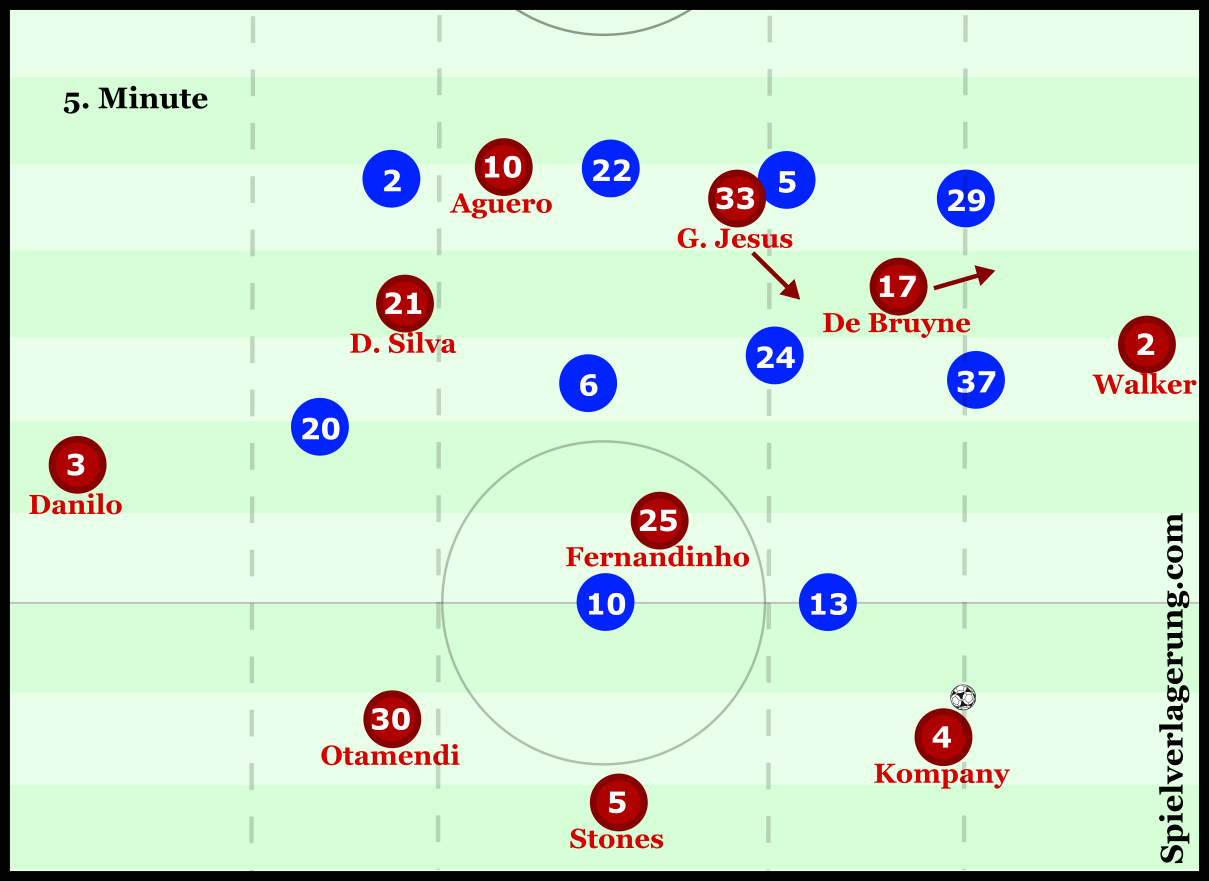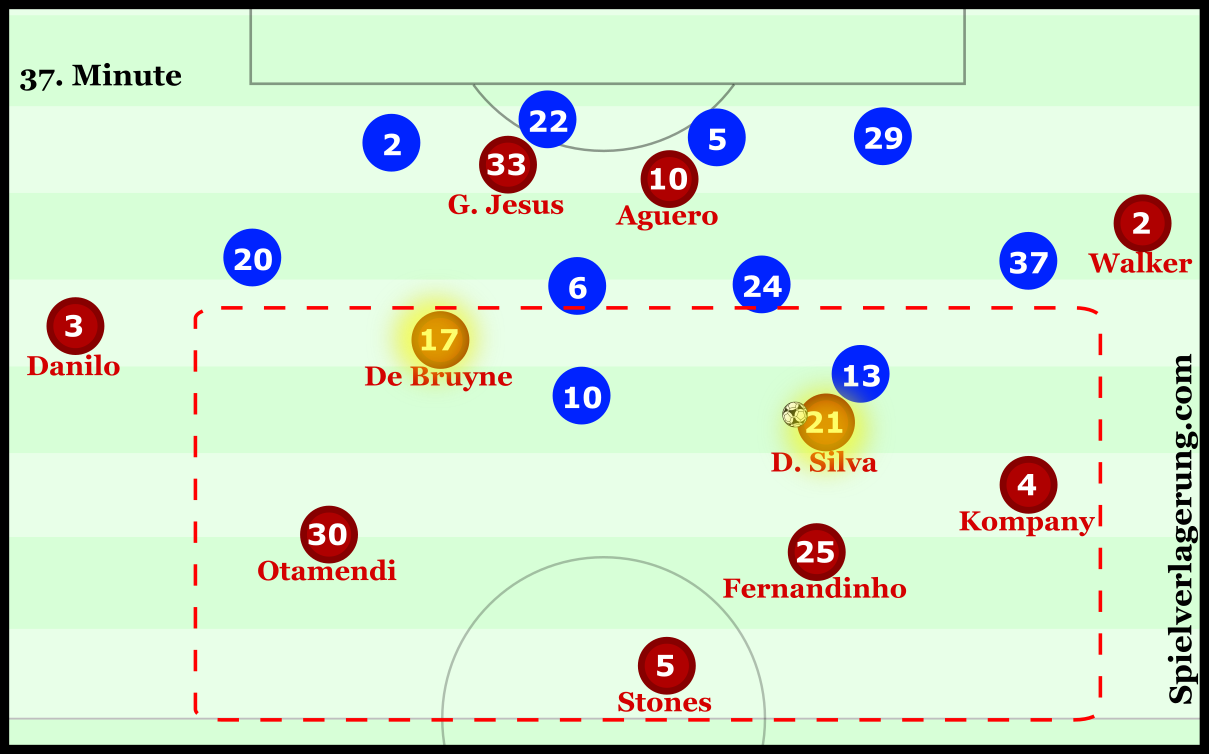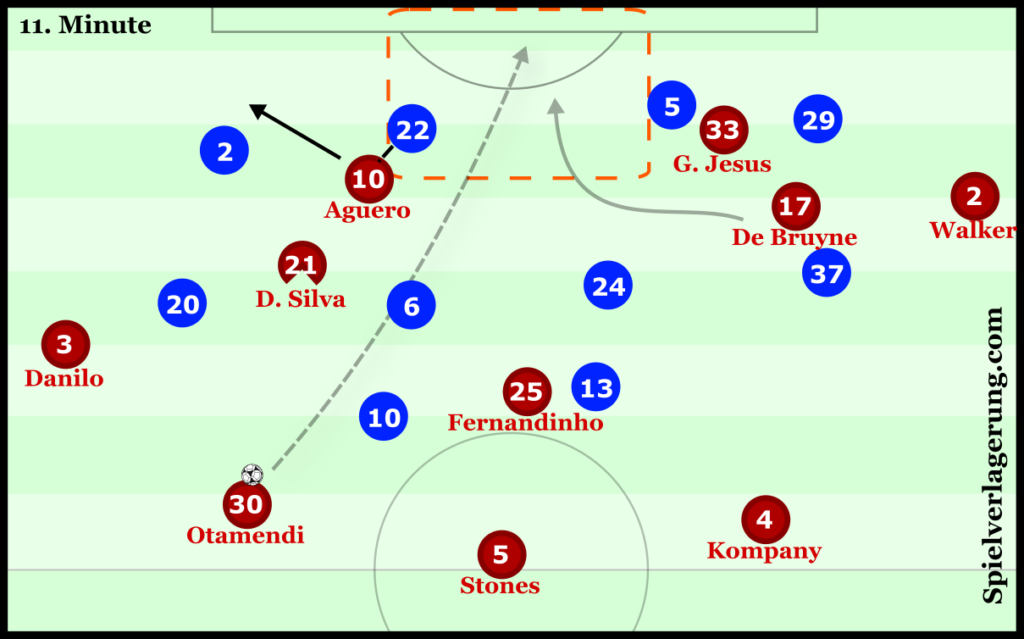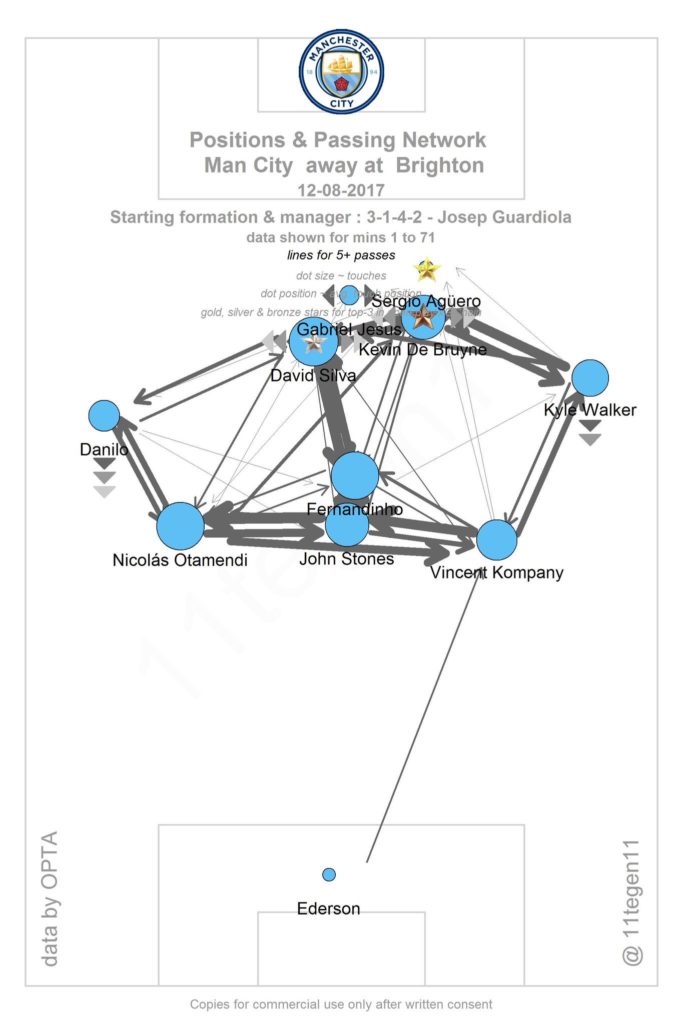Manchester City defeat Brighton to begin domestic campaign
Following an eventful summer in the Blue part of Manchester, Pep Guardiola’s team started off their Premier League season with a comfortable win over Brighton, who were newly promoted from the Championship. Although the implementation of the game plan could be accurately described as lethargic, some of the potential themes and modifications of this new Manchester City group were shown, with room for improvement on display as City shake off the cobwebs.
Changes in the Citizens’ Squad and Subsequent Tactical Implications
Before discussing the match, a brief discussion should take place about how exactly 2017/2018 Manchester City appears compared to Guardiola’s first season at the helm. While the hefty transfer fees for the new signings are always a point of contention among fans, the most notable component of this summer comes in the form of the departures. Nine first team players, most of whom made a considerable amount of appearances throughout last season, were told that they did not have a future at the Ethiad. Some examples that were influential (for better or for worse) to how City played last year include Aleksandar Kolarov, Nolito, Jesus Navas, plus every fullback on the books (Clichy, Sagna, Zabaleta).
Of City’s 5 new signings, all being under 28 years of age, three of them found their way in the starting XI today, with the former Monaco duo of Bernardo Silva and Benjamin Mendy not making their full debuts today (Silva would make a brief cameo in the late stages). Kyle Walker and Danilo each featured as wing backs on the day, while Ederson featured as goalkeeper.
Bernardo Silva adds competition at the loaded attacking midfield spots for City, alongside a dangerous dribbling threat on the counter attack, which has clearly been addressed so far by the coaching staff. Ederson as a goalkeeper provides superior shot stopping to Claudio Bravo, accompanied by excellent long range passing and distribution that can offer an additional solution to teams that wish to high press City during their buildup out of the back.
With Walker, Danilo, and Mendy, the obvious upgrade from their predecessors at fullback is in athleticism. Through increased speed and stamina, the new signings will be better able to complete the physical expectations in attack and defense that Guardiola has historically asked of his fullbacks/wingbacks. Moreover, these newcomers offer a lot more from the wing as seen in their roles at their previous clubs. This allows Guardiola to have greater flexibility with his team selection, as it can allow him to put his better attacking talent in more central areas, rather than leave them in wider zones like he did last year at times.
It could also potentially increase the speed of ball circulation by having a better network of connections through intelligent spacing in the halfspaces and center. In addition, a better solution to preventing counter attacks could be developed alongside a more prolific attack, perhaps seeing a return to more risky, less conservative tactics from Guardiola.
City’s Attacking Strategy
Brighton and Hove Albion were aligned in a medium-low block of 4-4-2, demonstrating good vertical compactness between the two banks of four with the purpose of restricting the space available to play in between the lines. Due to the man-orientations of Brighton, this shape would situationally adjust from time to time and this is largely due to Manchester City’s attacking shape. Because of Brighton’s focus on individual players, the horizontal compactness was not a shining example of the concept.
To break down the hosts, City were set up in a 3-1-4-2 in possession, which was normally in Brighton’s half as they rarely applied pressure to the three center backs. Stones was the deepest of the three center backs in his central position, acting as a pivot, while Otamendi and Kompany took up positions slightly in front of Stones in their respective sides. Fernandinho meandered in front of the back three, while Silva and De Bruyne frequented the left and right halfspace respectively.

City’s general attacking positions against Brighton’s defensive block – with some movements found in this scene.
A short distance away horizontally from the skillful interiors was where Danilo and Walker typically were positioned, occupying the wings by themselves with support from the strikers and central players, while the closest center back would offer themselves as an option out to recycle the ball. Aguero and Gabriel Jesus would alternate between showing towards the ball and looking for penetration in behind Brighton’s defense, occasionally drifting into wider areas to ensure occupation of all areas of the field depending on the movement of their teammates.
The away side allowed for greater positional fluidity in the final third, with Walker’s movement in particular of note. In multiple situations, Walker would run inside from his wide starting position, using his dynamical and speed advantage to offer a dangerous solution in behind the opposition which when paired with a well-timed pass, could be one of many weapons at the Citizens’ disposal. When this occurred, the nearest player would occupy his vacated position, showing a high frequency of interchanging and moving from their base positions throughout the match in several instances, not just Walker’s movements.
Despite the previous words, the intended focus of City’s attack was trying to penetrate through central areas, using Silva and De Bruyne in advanced spots to be able to link up with with the tandem up front while using wide areas as a means to get behind. Therefore, it was imperative that the speed of play was high in order to be able to unbalance the block of Brighton to get the star men on the ball. Despite being in Brighton’s half for most of the match however, City found quality chances difficult to come by for the majority of the match for a myriad of reasons.
Issues and Adjustments
In the match however, some issues arose with Manchester City’s positional play and decision making that prevented them from consistently threatening the home side. Of course, it’s natural to have some things to iron out on the first match of the season, but Man City’s performances in preseason foreshadowed a high chance of starting with a bang. Prior to this season, IB wrote about City’s positional play issues from last year, which can be found here.
A likely reason for these complications with City’s performance is Guardiola’s conservatism that has been deployed away from home. Pep in the past has opted for less adventurous tactics on away days, preferring to have more structural stability to prevent conceding goals off of counter attacks. This trade-off between safety and risk can lead to the use of the personnel of the squad not being optimized when choosing safety, such was the case today.
The desire for safety throughout the team was evident in the decision making of the center backs, who rarely exercised any kind of risk in their passing. The pass selection from the trio rarely went in between the defense of Brighton, rather around them. Typically, the back three just passed among themselves and with Fernandinho, who either was way too close to the back 3 to be an effective option for the build up, or too advanced to be considered an appropriate option.
A lack of speed of play on the ball from the back three and Fernandinho is a large part of why they struggled to seriously penetrate the home side in central areas. While constructing the attacks, each of these players took excessive touches and dribbles in unnecessary situations. During this time, Brighton can adjust to the new positioning schemes of the players higher up the pitch. By the time Otamendi for example contemplated playing the forward option centrally, Brighton had already covered the player and it was no longer an attractive choice. If the time on the ball were to be decreased, so would the time Brighton has to react to any movements, leading to more lucrative and successful attacks for City.
Since there weren’t many attractive options centrally, that led to a lot of wide distribution from the back 3. A common means of progressing forward was via the dribble of Danilo and Walker, who would have the player closest to them delay them in order to preserve the organization of their defensive block. From there, attempts three man combinations in wide zones would occur, but Brighton generally dealt with these well. Once City began to realize this, they began to switch the play through the center backs via flighted diagonal pass. While these passes are technically difficult, Walker or Danilo would receive the ball and not have adequate support around them due to the team positioned around the side the ball just came from, just restarting their build up woes again.
Unsatisfied with their influence in the match, De Bruyne and Silva began to drop deeper in order to receive the ball since they weren’t getting many touches previously. While this sounds like a fine solution for that issue since it will increase the time on the ball for those players, it creates a superiority a part of the pitch where it is not needed. With both Silva and De Bruyne dropping, a 6v2 superiority formed in an area of the pitch that offers no danger.

Both Silva and De Bruyne should be higher up the pitch, in order to position themselves in more dangerous areas closer to the goal. Instead, they drop deep to get the ball.
This stifles the progression of the attack and leads to not having adequate options higher up the pitch. To provide better options, both should’ve remained in their respective horizontal lines to move the opponent to free space up the pitch, rather than drop deeper and receive the ball in nonthreatening spots. Spielverlagerung writer @feyre9251 sums this up nicely with the following quote.
“When you try to execute a positional idea… you should move players from the first lines to next ones, not the opposite.” – feyre9251
Of course, those positional components depend on the players with the ball willing to make the pass into players in those spots. The forwards experienced their own frustrations with the risk averse passing tendencies of the deeper players. As Aguero and Gabriel Jesus would make runs in behind the defensive line, Duffy and Dunk would follow their man in order to reduce the danger in the event of them receiving the ball.
At times, Brighton were unaware of how large the gap was in between the center defensive duo, which City could’ve capitalized on if a second movement into the space took place. By using the first movement as a decoy, the visitors could’ve penetrated by playing long into the space provided that the run started from a deeper position so that the runner can time the ball well and break away from his marker more easily. In addition, it forces the defender with a man occupied into a decisional crisis, as he has to choose between staying on the player he was initially covering, or follow the runner close to him that is on path towards goal. This is one method of how the away side could’ve found themselves in more dangerous positions on the afternoon.

Aguero takes his marker away, leaving large space open in the middle. If a second run followed, City had a good opportunity to break in behind via the long pass.
Lastly, City’s attack was not optimized due to the wrong footed wing back that was Danilo. When wingers play on the side opposite to their natural foot, it is done with the idea that by cutting inside, they can balance the defense better and create scoring opportunities for themselves and their teammates. It is a common sight to see fans moan (or celebrate) when Arjen Robben scores one of his trademark goals where he cuts inside on his left foot, because it is extremely predictable since he is extremely one footed.
However, Danilo is not Robben (shocker), and he does not offer that same sort of threat on the opposite side. He does have a similar level of predictability though. Since Danilo was so reliant on his right foot throughout the match, Brighton effectively didn’t have to defend the left wing when he was on the ball, and it essentially reduced the amount of space they had to defend. In response, most of City’s attacking chances were developed on the right side, because there was a superior dynamic on that side and less of a predictable element.
Halfway through the second half, Leroy Sane was introduced in place of Danilo. The affect he had on City’s attack was evident, in that they became less reliant on the right side for chance creation. Sane offered more of a dribbling and scoring scoring threat than Danilo, and within moments of him coming on, the tempo of the attack for Manchester City increased. Sergio Aguero put away the first goal shortly after, and after an own goal from Lewis Dunk following a cross six minutes later, Guardiola’s men were able to coast to victory.
Manchester City Out of Possession (and their anticipation of these moments)
In the rare moments that Manchester City did not have the ball, their counterpressing was impressive to deny Brighton from being able to play forward. De Bruyne was instrumental in this regard, as his timing and application of pressure was strong both in transition, and on Brighton’s technically shaky defenders. Both Silva and Fernandinho were valuable in applying immediate pressure to the ball carrier, but the frequency of fouls was high relative to how little they were out of possession thanks to how they pressed.
When Matthew Ryan received the ball, Aguero or Jesus put him under pressure to force the ball long. City won a fair share of the aerial duels in the contest, bolstered by the back three who are all physically impressive. When Brighton would clear attacks using their heads, Kompany and Otamendi each took up advanced positions relative to Stones in which they were in spots that they could attack the ball right away.
Rather than stay near half, they gradually moved up the defensive unit so that Brighton could even manage to get a sniff of possession when they were in their deep block. The newly promoted club seldom had a counter attack, and when they did, City’s line stepped up intelligently to force them offside.
Conclusion
Manchester City will be satisfied to have gotten a win from their first game, but will hope to make improvements in their attacking play, as many English teams throughout the season will use a similar strategy as Brighton against them. With Guardiola in charge and a new slew of players joining the crew, they are a popular pick to win the Premier League for this coming season. However, it is still evident that there is a lot of learning and adaptation from the players required to fluidly play the positional play that Guardiola wants to instill. If this is finely tuned throughout the squad, Manchester City could be a dangerous team in domestic and continental competition.




Keine Kommentare vorhanden Alle anzeigen